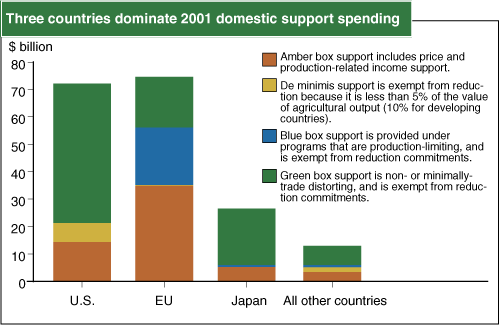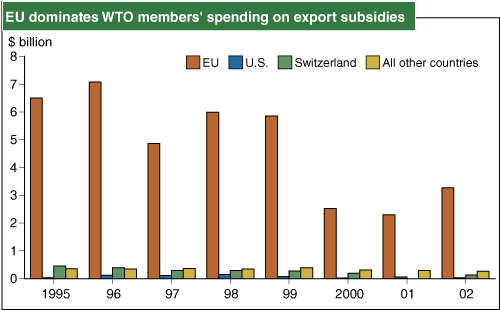Behind The Data
- by Cynthia Nickerson
- 9/1/2006
WTO Trade Policy Commitments Database
Under the Agreement on Agriculture, World Trade Organization (WTO) members agreed to rules governing the type and level of agricultural policies they may use. These rules fall under three areas: domestic support (price support and producer subsidies), export subsidies, and market access (tariffs and tariff-rate quotas). Countries agreed to limit domestic policies considered to be trade distorting, reduce their use of export subsidies, and decrease tariffs. They also agreed to allow for a minimal level of imports of some products through tariff-rate quotas—two-tiered tariffs with a lower tariff levied on imports up to a certain quantity.
WTO member countries are required to report on their compliance with commitments under the Agreement on Agriculture. The ERS WTO Trade Policy Commitments Database assembles WTO member notifications and displays the information in a user-friendly format with various options for viewing and downloading data. ERS has calculated the U.S. dollar equivalent of WTO member expenditures on domestic support and export subsidies, and aggregated detailed tariff data by commodity category, facilitating comparisons of data across member countries. The data provide a profile of countries’ agricultural support and protection.
Domestic support data in the ERS database includes annual levels of support by WTO members, how the countries provide it, and how they spend it. In 2002, the European Union (EU), the United States, and Japan accounted for 93 percent of all domestic support outlays reported to the WTO and 94 percent of the most trade-distorting support.
Export subsidy data include expenditures on export subsidies and the quantity of subsidized exports, by commodity. Since 1995, worldwide use of export subsidies reported to the WTO has declined by half, aided by a strong U.S. dollar and high world market prices for many agricultural products in 2000-02, as well as by policy reforms that reduced the need for export subsidies. Over the same period, the EU has been the largest user of export subsidies, accounting for 90-95 percent of the total reported by all WTO members.
Tariff protection data include both bound (the maximum tariff levels countries can charge) and applied (lower tariffs that some countries actually charge on imports) tariff rates, as well as in- and over-quota tariffs for products with tariff-rate quotas. Against a high global average rate of 63 percent for WTO bound tariffs, bound tariff levels vary considerably across regions and among products.
This article is drawn from:
- Trade Policy & World Trade Organization (WTO). (n.d.). U.S. Department of Agriculture, Economic Research Service.
You may also like:
- ERS/USDA Data - WTO Agricultural Trade Policy Commitments Database. (2009). Economic Research Service.



